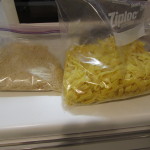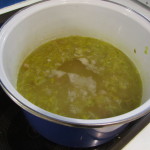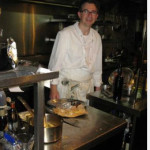http://thisisthewilderness.com/about/company/ We decided to stay close to home today, trim the flowers out front and maybe take a walk around the neighborhood.
Tamamura I love it when a plan comes together. Â Pat was puttering out front with some flowers that
looked like they were half dead shortly after we arrived. Â We realized they were under the overhang so they were getting no water. Â We watered them and they returned to life so today Pat planted them so I snapped some photos.
While Pat was planting I did a bit of cooking and food prep. Â I cooked off some fresh egg noodles for a dinner
at a later time and made some potato leek soup which we will have for dinner to night soon.
I also remembered to call Hugo at

Noodles and bread crumbs from left over baguettes.La Cordonnerie for reservation on Wednesday night in the Kitchen. It’s hard to believe we have been here two weeks and have not gone to La Cordonnerie for
La Cordonnerie for a reservation on Wednesday night in the Kitchen. It’s hard to believe we have been here two weeks and have not gone to La Cordonnerie for
dinner, my guess is that our late arrival completely threw off our schedule.
We decided to take the bus over to the Parc Monceau and get some exercise and fresh air and also take some photos.
A LITTLE HISTORY ON THE PARC MONCEAU:
In 1769, the Duke of Chartres, acquired the land on which he built the “Folie de Chartres” surrounded by a garden “in French.” He later commissioned amateur landscaper/writer/painter Carmontelle to create his garden.  Carmontelle’s theatrical background yielded a garden of dreams which gave a unique, exotic at the Parc Monceau drawing inspiration from English and German trends of the time. Visitors saw the emergence of buildings of all styles and from all eras: the ruins of a temple of Mars, and a Gothic castle, minaret, Dutch windmill, Egyptian pyramid, Chinese pagoda tent tartare, many small buildings fantasy that made it famous Anglo-Chinese garden.
Rivers were dug, and the famous Naumachie, a basin surrounded by Corinthian columns (in Ancient Rome it was a pool which was used to mimic naval battles),  Carmontelle was even inspired by Grave Valois of the Basilica of Saint-Denis. Parc Monceau was divided in 1787, by the construction of the wall of the Farmers-General. The Pavilion of Chartres with its rotunda of columns, served as a tollhouse and was built by Ledoux, adjacent to the current boulevard de Courcelles.  A part on the first floor, that you can still see, was converted into a lounge by the Duke of Chartres, from which he could admire a breathtaking view over the plain of Parc Monceau. In 1793, a greenhouse, a conservatory, and new paths arose under the leadership of Thomas Blaikie, author of the wonderful Parc de Bagatelle, who transformed the Parc Monceau in English garden.
Parc Monceau became national property during the Revolution, it was returned to the Orleans family, but it did not stay in their hands very long. The state acquired it in 1852. Parc Monceau was then changed dramatically. Financial woes caused part of the park to be sold and many mansions on the sides East, South and West, including museums Cernuschi (Asian art) and Nissim de Camondo (18th century) were built. They are now part of the prestigious district of Monceau, but the park was therefore cut in half, reduced to 22 acres. Drawings Parc Monceau were modified for the last time by the engineer Alphand, the architect and horticulturist Davioud barrel-Deschamps, who worked under the orders of Baron Haussmann. In 1861, Napoleon III was finally able to inaugurate the Monceau park we know today.
Walking:
The appearance of the Parc Monceau has not changed since then, and Marcel Proust who loved to wander recognize it easily. You enter the Parc Monceau by large wrought iron gates with gold enhanced, four-doors bear the signature of Davioud. Parc Monceau is one of the most beautiful gardens in the capital, visited by mothers and their children, some tourists and the Russian community who attend to the Orthodox Alexander Nevsky Cathedral (1861) nearby.
Enjoy the tranquility in the Parc Monceau, isolated by a green belt, of luxury buildings and luxurious mansions. You will find many statues (monument Gounod -1897 – and -1906 Musset – Antonin Mercier, Chopin by Jacques Froment Meurice -1906 – Ambroise Thomas Alexander Falguière -1902 – Guy de Maupassant by Raoul Verlet -1897 – Edward Pailleron Leopold Bernstam -1906 -), and among the sights, a Renaissance arcade of the Hotel de Ville de Paris which burned during the Commune.
Monceau Park is home to spectacular trees including a sycamore with twisted branches, which is the oldest (1853), the largest (4.18 m) and the highest in the district (30m). However, his impressive girth easily competes with that of the oldest Oriental plane (1814), which reached 7 meters!
The massive antlers of a purple maple “on elephant skin” thriving in the midst of a multitude of other trees (Corsican pine, hackberry Provence, Paulownia, silver linden, honey locust, tree of Judea, tulip tree, tree with pockets …) small shrubs and ever-changing floral baskets.
Parc Monceau is also green area of ​​the district which contains a great diversity of birds – which we heard on our walk today. They are attracted by the shelter of the high trees and the cool fresh waters of the basin, inhabited by big carp and smaller goldfish. If you go to the  Parc Monceau in May, you will witness mallards escorting their young chicks. Tit nun, which is often observed in the garden, always move in pairs.
Jays are also regulars at the Parc Monceau. They are easily recognizable by their light beige plumage and a spot of a bright blue on their wing. Their cries are inharmonious and some are able to imitate other species, even the mewing of a cat! Readily distracted, or overcome by OCD, they abandon often unintentionally acorns they hid too well, which helps increase the number of oaks.
The Allee Michael Berger
The northern half of the allele in the Parc Monceau was named Michel Berger in December 2012. It is 210 meters long. This performer, composer, producer and artistic director marked the French popular culture, in the late 1980s.





